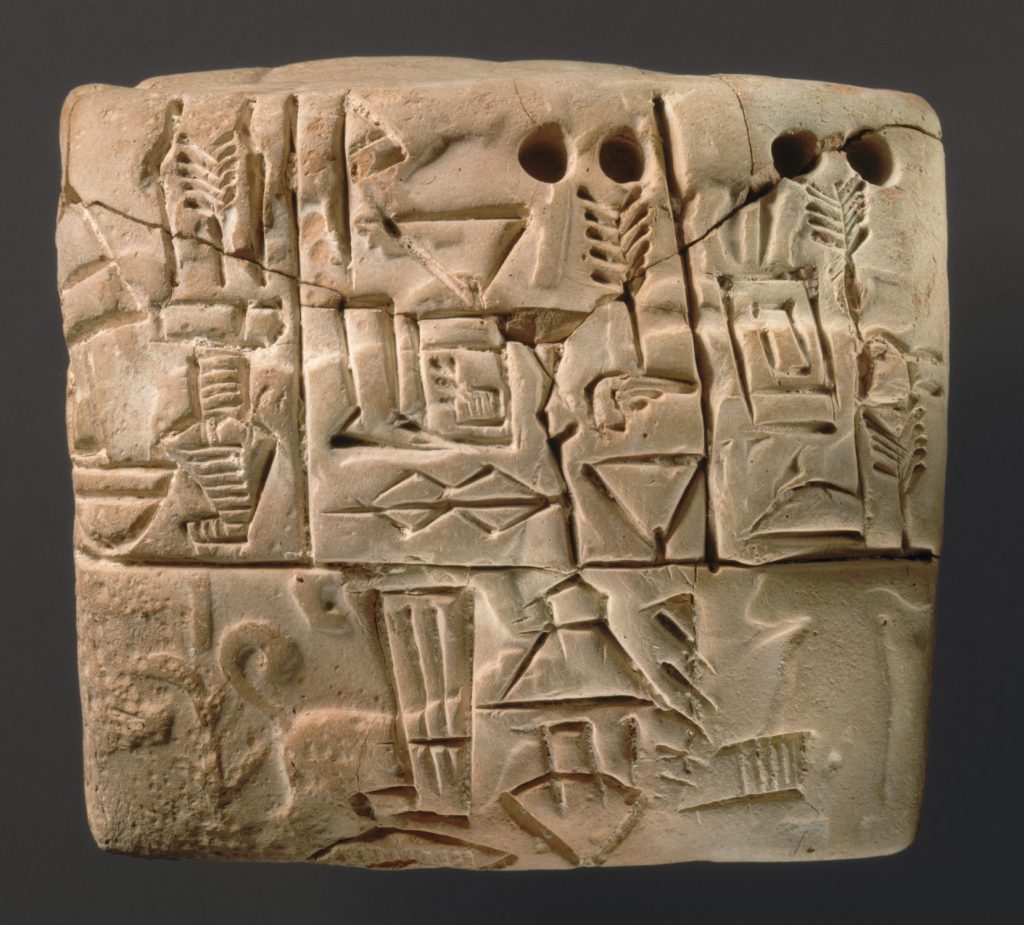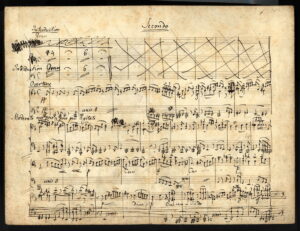Written language, which is perhaps taken for granted in the 21st century, was not common for early civilizations. Around 3,000 B.C.E. the first writing system was created by the Sumerians. The Sumerians developed their civilization in present day southern Iraq; they evolved into complex societies with large cities and centralized economies. The origin of their writing system developed to keep track of inventories of things produced, such as grain and livestock. From their records emerged the first written form of any language, called cuneiform.1
Literally meaning “wedged shaped,” cuneiform was written by using a stylist on a damp piece of clay. The clay was then baked to harden the inscription. Cuneiform developed from sounds of the Sumerian language. As time progressed, the writing became more and more complex. The forms went from being an inscription of an object, such as sheep, to more abstract representations of words, such as “the sheep walk to the temple.”2
Cuneiform is the oldest written language, but even the oldest language has its own origins. Recent archaeological research has found evidence for the origin of writing to be more complex than originally thought. Some recent discoveries of even older writing, called proto-cuneiform, were found in Syria and Turkey going back to the mid fourth millennium. These inscriptions are pictorial, much like hieroglyphs of Egypt. Many of them are decipherable, but most are so abstract that they cannot be identified with known objects. Some of these were even written on wood instead of clay. The tablets found from the Sumerian people are only a small fraction of the earliest writing. The Sumerian tablets are from the time when writing became standardized, as a result of rapidly growing Sumerian city-states. The need for a normalized way of writing with standard symbols that people could recognize was apparent, so they shifted from pictographs to a standard script. The script became the writing we know today as cuneiform, and it also became a new way to record other things, such as stories and legal codes.3

With the development of more complex writing came the first pieces of real literature. The Epic of Gilgamesh, written between 2150-1400 BCE, is the oldest known work of literature. The story comes from a long oral tradition that was passed by word of mouth for centuries. The development of cuneiform allowed the story to enter history as a written record. In addition to literature, legal writing emerged in the form of legal codes, such as the Law Code of Hammurabi, created sometime between 1794-1750 BCE. The Code of Hammurabi has almost three hundred laws that applied to the daily life of the Babylonians. The range of the law code is broad, from family life to administrative laws. The Code of Hammurabi is the oldest extensive law code known.4
Cuneiform set the stage for subsequent written languages. Its origins came from pictures, but then became representations of sounds of spoken language. Now writing is something people use everyday. People read books, articles, text messages on smartphones; all these means of communicating have their origin in cuneiform.
- Jerry Bentley, Herbert Ziegler, and Heather Streets Salter, Traditions & Encounters: A Brief Global History, Volume 1, 3 edition (McGraw-Hill Higher Education, 2013), 16. ↵
- Ancient History Encyclopedia, October 2010, s.v. “Cuneiform,” by Joshua J. Mark. ↵
- Ira Spar, “The Origins of Writing,” in Heilbrunn Timeline of Art History (New York: The Metropolitan Museum of Art, 2000–.) http://www.metmuseum.org/toah/hd/wrtg/hd_wrtg.htm (October 2004). ↵
- Bentley, Ziegler, and Salter, Traditions &; Encounters: A Brief Global History, 10-11. ↵



39 comments
Erin Vento
Its really interesting to think about how much language, or communication in general, has changed. Even looking at the picture you included, it’s just hard to believe that that was a way of writing and understanding for people. I like how you explained the creation or process it took to create/ get to cuneiform; most of the time you don’t think about how something as basic for us as communication was got created- great, informative article.
Steven Clinton
Great article, it’s interesting to see the evolution of written language; from pictographs to modern day words. Cuneiform is the foundation of written language in that it set the base to build on. Cuneiform like many other things started small but then would later develop and become more advanced as time would past. Good sources and details within the article.
Gabriela Serrato
I was so glad to come across this article because I had always wondered about the writing and its origin. It was nice reading about who in fact were the first people to begin writing. I found it interesting that the Sumerians developed writing as a way to keep track of their inventory. I always imagined writing was originally created as a way of communication, so I thought that fact was interesting. One line in the beginning of the article really struck me because of how much I agree with it. People do take writing for granted, and people may not even realize how different our lives would be without it.
Cameron Mays
I understand that your ariticle is just talking about the origin of writing, but I wish you would have expanded it to talk about language as a whole, and how being able to convey it in writing is so important. Without this skill, almost nothing could get done, which is why I would have liked for you to talk about it. The way you wrote your article was quite well done though. It seems researched enough and the product is a very tasteful article that doesn’t drag on needlessly and covers the topic you wanted.
Luke Trevino
Growing up in school I had heard of cuniform but never in such depth as this. It’s awesome how when they needed to remember something they had the idea to write it on clay and heat it! These people where truly advanced and ahead of their time! It was also cool to see how they went from pictures to actual script! Overall very well written essay and very informative.
Marissa Gonzalez
Looking back at the way others communicated with images seems difficult to me and possibly seems difficult for others as well. However, those who knew cuneiform understood it since it was their way of communicating. I find it fascinating how much script has changed over time from pictures to writing cuneiform, to our developed languages today. I cannot imagine learning how to draw to communicate with someone; especially on a wooden or clay tablet. This article is well written and shows us how much our language and ways of communicating have emerged throughout time which is impressive. Great job with this article!
Sergio Cervantes
It is interesting to read about the first writing system and how it emerged to be used as a tool for societies. It’s crazy to think that clay tablets were used to write on instead of sheets of paper. The fact that we are still able to decipher some writings is astonishing, especially due to the complex characters of the Sumerians. Another thing that I found fascinating was its usage to create legal codes to determine how one would live.
Johnanthony Hernandez
Interesting to see that cuneiform had a precursor to what it became and from what I can understand, it seems to be more complicated. I came in knowing that cuneiform is considered to be the oldest written language, but I didn’t know roughly how old it was. The shift from the pictographs that had been used as more of shorthand symbols to an actual written language that was used for keeping record and eventually giving us our first written laws through the Code of Hammurabi is amazing. Great article.
Jacob Hall
It’s easy sometimes to forget the level of impact ancient people have on us today. I think you do a great job of reminding us of that impact. One thing I love to do is write in my free time but drawing is not a strong point of mine, so the creation of cuneiform is a blessing to me. Also I find it funny that the word itself means wedged shape and not something like written word.
Erik Rodriguez
It is just amazing how we have been able to evolve from carving into clay to typing on a touch screen. I couldn’t imagine trying to be so patient and carving out writing into a clay tablet. Now-a-days, everything is so fast and technologically advanced, you don’t even get to appreciate how easy it is to communicate with people. After reading your article, you have opened my eyes on how much we have progressed and the simplicity of writing today.
Great job! Keep up the good work!